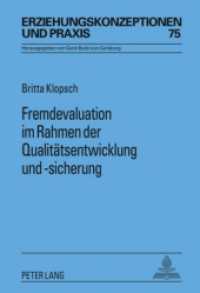Full Description
This book explores the value of duoethnography to the study of interdisciplinary practice. Illustrating how dialogic and relational forms of research help to facilitate deeply emic, personal, and situated understandings of practice, the editors and contributors promote personal reflexivity and changes in practice. Education, drama, nursing counselling, and art in classroom, university, and larger professional spaces are examined by students, teachers, and practitioners using duoethnography to become more aware, dialogic, imaginative, and relational in their teaching.
Contents
Chapter 1. The Efficacy of Duoethnography in Teaching and LearningReturn to its Roots Chapter 2. Teaching through Duoethnography in Teacher Education and Graduate Curriculum Theory CoursesChapter 3. Right and Wrong (and Good Enough): A Duoethnography within a Graduate Curriculum Studies Course Chapter 4. Dialogic Life History in Preservice Teacher Education Chapter 5. Duoethnography as a Pedagogical Tool that Encourages Deep ReflectionChapter 6. Exploring Duoethnography in Graduate Research CoursesChapter 7. Community, identity, and graduate education: Using duoethnography as a mechanism for forging connections in academia







